Introduction
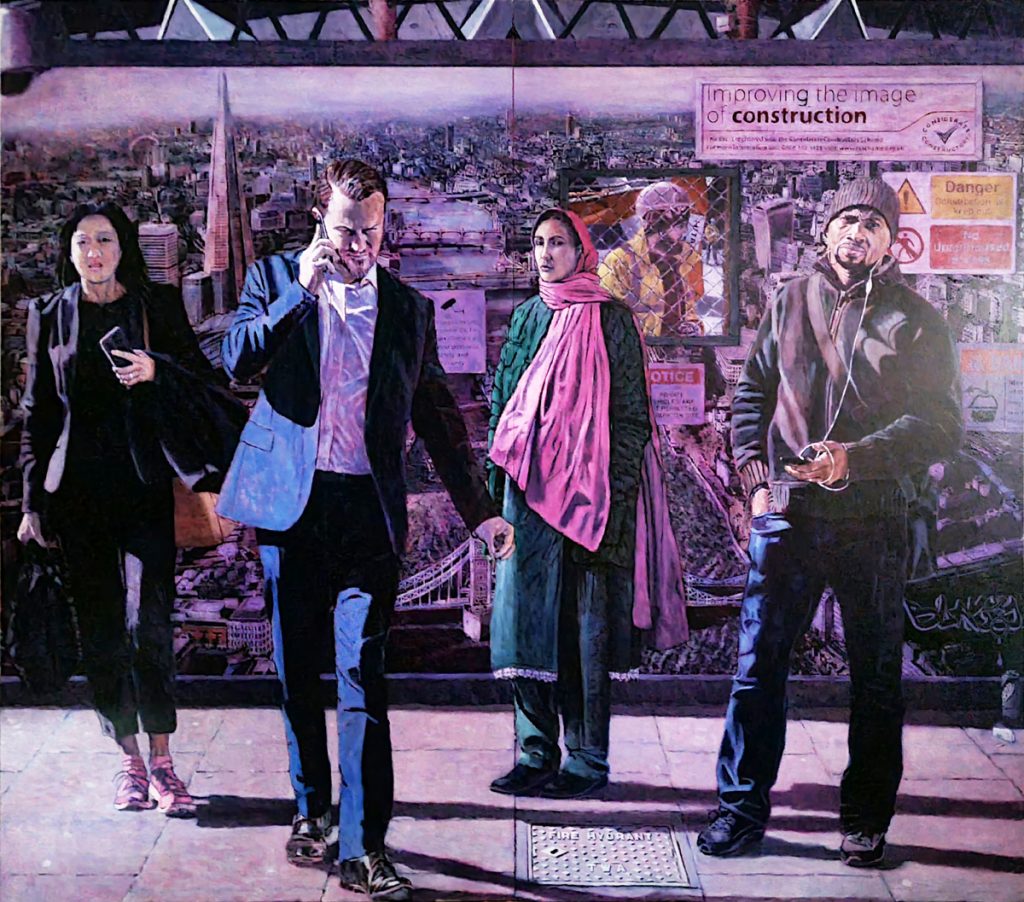
185 cm x 210 cm – diptych, oil on MDF, 2022
I began work on this painting in November 2021. However, the germ of an idea
was planted in July 2012 when I spent time photographing parts of London before
the opening of the Olympic Games.
The Shard was about to open so I headed to London Bridge, which is where I saw
the hoarding next to the Shard – shown below.

It left an indelible impression. The city had been captured from the air, and I
thought I would incorporate it into a painting at some point. It was not until the
following year that I began making a series of figurative paintings that signalled a
departure from my previous work, which, although inspired by my environment,
was highly abstracted.

Showtime, oil on MDF
Showtime is a good example of where my work was heading. Painted in 2013, it
incorporates both figures and urban architecture.
Fast forward to 2021, and I intended to make something more ambitious in scale
and subject matter. That subject was London, my birthplace and where I have
spent most of my life.
The starting point was that hoarding. Then I read a poem by William Blake.
William Blake’s London
I wander thro’ each charter’d street,
Near where the charter’d Thames does flow.
And mark in every face I meet
Marks of weakness, marks of woe.
In every cry of every Man,
In every Infants cry of fear,
In every voice: in every ban,
The mind-forg’d manacles I hear
How the Chimney-sweepers cry
Every blackning Church appalls,
And the hapless Soldiers sigh
Runs in blood down Palace walls
But most thro’ midnight streets I hear
How the youthful Harlots curse
Blasts the new-born Infants tear
And blights with plagues the Marriage hearse
Blake’s poem was published in 1794, and I am happy to report that much has
changed for the better. However, there are parallels with my own experiences of
the city.
As a boy, I often walked along the streets of London with my father. He instilled in
me a passion for its history and architecture. We also took trips by boat, both east
and west, along the Thames. I did the same with my own children, and despite
often cursing it, my love for this city has lasted a lifetime.
Working method
My working method involves ‘breeding’ images using my photographs and
Photoshop.
Since I was painting it at home, the support would need to be split to move it to
another space. So, with that in mind, I produced many images, one of which
would act as a starting point for the painting. I emphasise starting point because
things always change once I begin painting
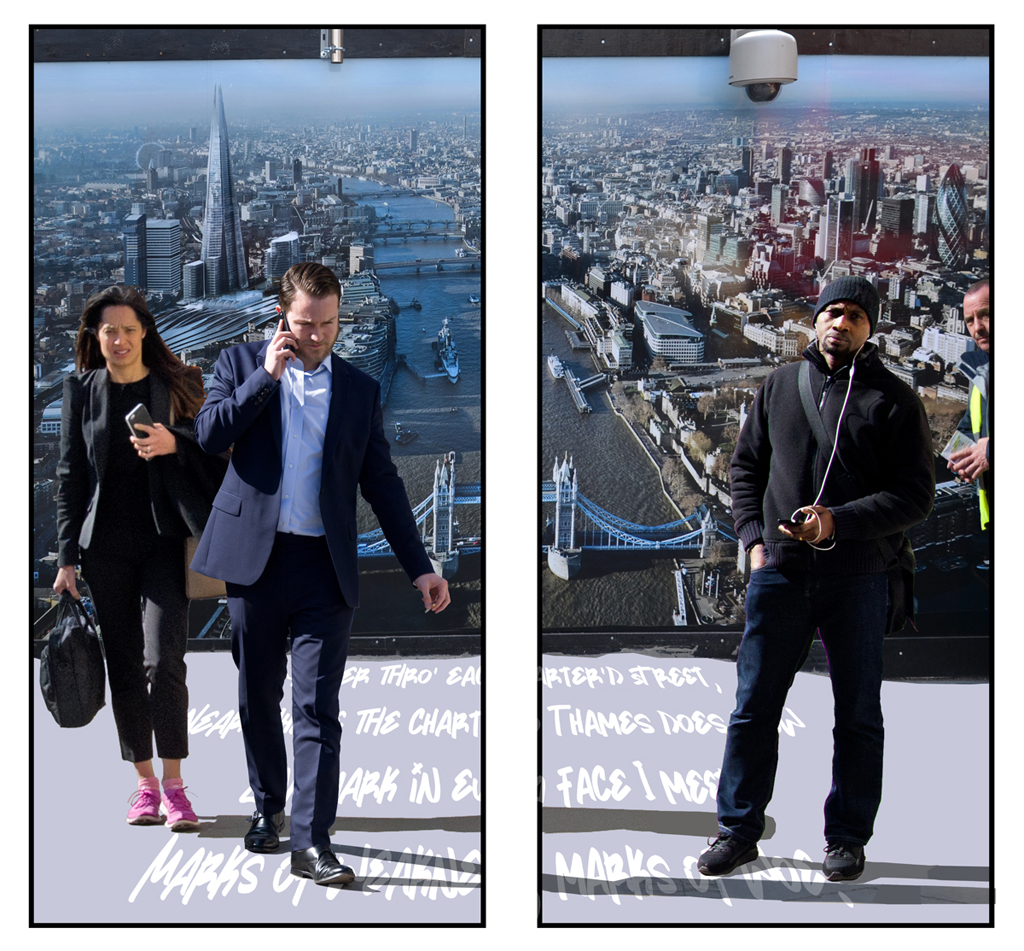
Mock-up of planned painting using Photoshop. Note that at this stage I envisaged two separate panels. This soon changed.
After some research, I came to believe Jason Hawkes took that aerial photograph.
I was concerned about infringing his copyright, so I decided to talk with him. He
was friendly and helpful. However, on looking at my photo of the hoarding he was
unsure whether The Shard’s developers had used his work. Nonetheless, he said
that if it was his, he didn’t have a problem with me using it in the way I envisaged.
Since that photograph was taken the skyline has changed, such is the nature of
London. I adjusted accordingly by inserting several buildings, including the Blackfriars development and 30 Fenchurch Street, aka The Walkie Talkie, which wasn’t completed until 2014. A helicopter was not available, so I used Google Earth.
At that stage, the picture space was very compressed. To extend it, I introduced
an inspection hole in the hoarding to provide a glimpse of the space beyond,
something that modern construction sites often provide for public viewing.
I painted various scenes for that space, but none of them felt right. So, I took a
morning out and went to the City, where I found a construction worker and a suitable backdrop, St Mary Axe, better known as The Gherkin. Later, I tacked on a
chain-wire grille, which adds to the sense of the flatness of the hoarding.
This structure also chimes with other paintings where I arranged spaces parallel to
the picture plane. The inspection hole can also be viewed as a picture within a picture – another motif I often use.
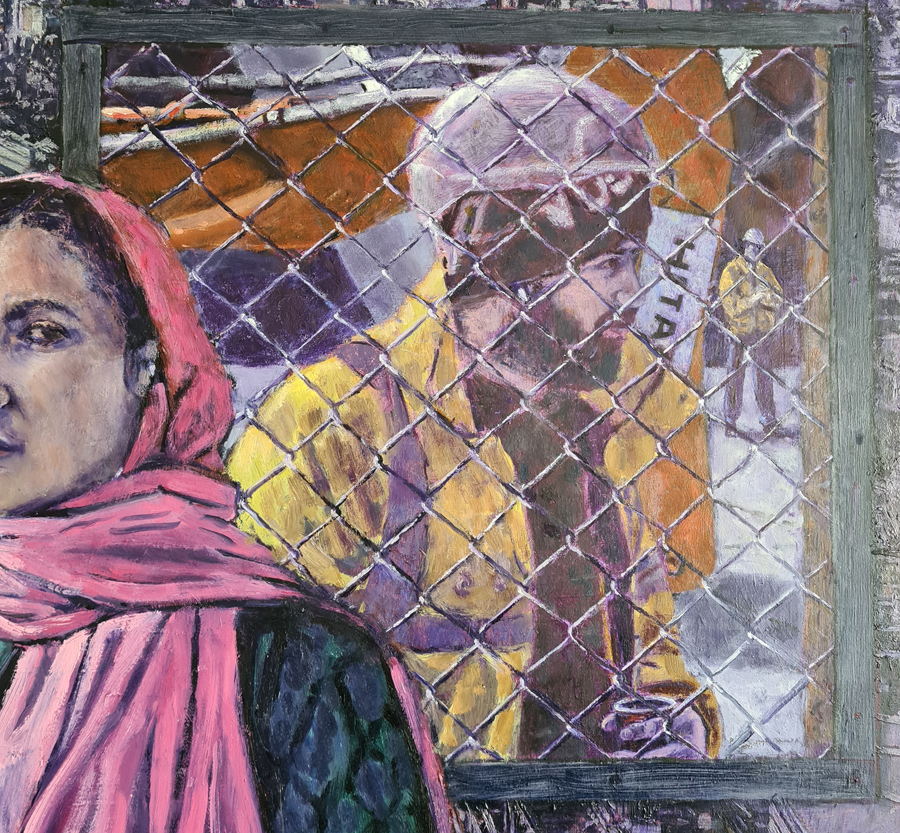
The inspection hole. A picture within a picture. Detail.
It took a long time to make sense of the space beyond the hoarding. The tiny
figure of a construction worker was added almost at the last moment to give a
sense of distance between the hoarding and the Gherkin.
A considerable amount of abstraction was involved. But as Matisse once said,
exactitude is not truth … or so I keep telling myself.
This piece of the painting also unifies the light with that of the foreground. It also
allowed me to use some lovely colours like Indian Yellow. Blake’s poem had to
make an appearance. So, I invented BLAKEY, a street artist. His tag includes
Blake’s reference to ‘mind-forged manacles’ and several tears. The can of Loop
spray paint is a popular brand used by graffiti artists.
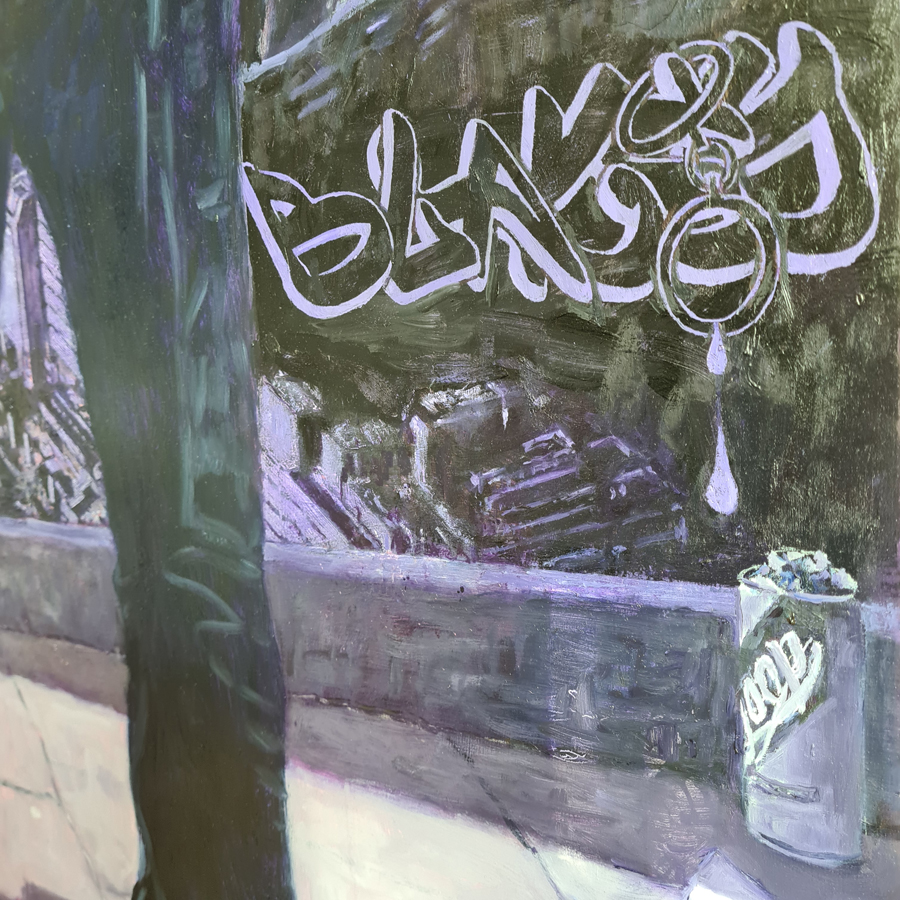
Foreground Figures
The initial three figures are based on people I observed in the City of London,
namely on Threadneedle Street by the Bank of England, and on Watling Street. I
had intended for the Thames to act as a substitute for a figure. That did not work,
and it left me with a large ‘hole’ in the picture.
It took several months before I took the plunge and obliterated a large chunk of
Tower Bridge with a fourth figure. She is based on a woman I saw on the concourse of Liverpool Street Station. I changed the colour of her jacket and pashmina. Her face is pure invention, as is the woman’s face on the left of the picture.
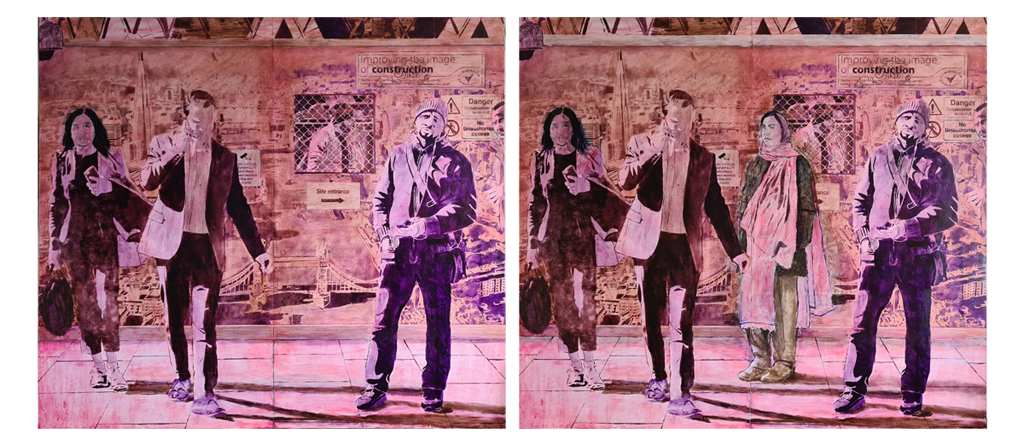
Changes made to the painting with the addition of the new figure
Influences
Manet
As I have written elsewhere, my work has been greatly influenced by Manet, particularly the way he constructs forms and space using lively brushwork, as well as his use of black outlines to strengthen those forms. Consequently, I have tried to move my work in a more painterly direction.
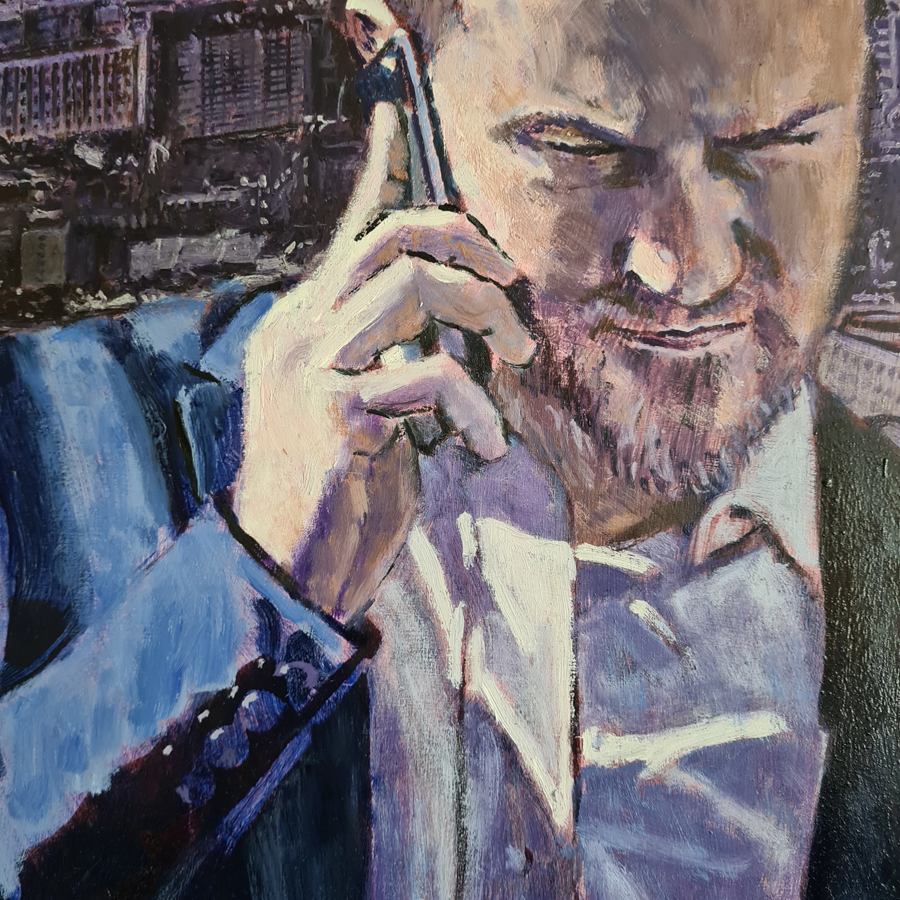
The Fourth Estate
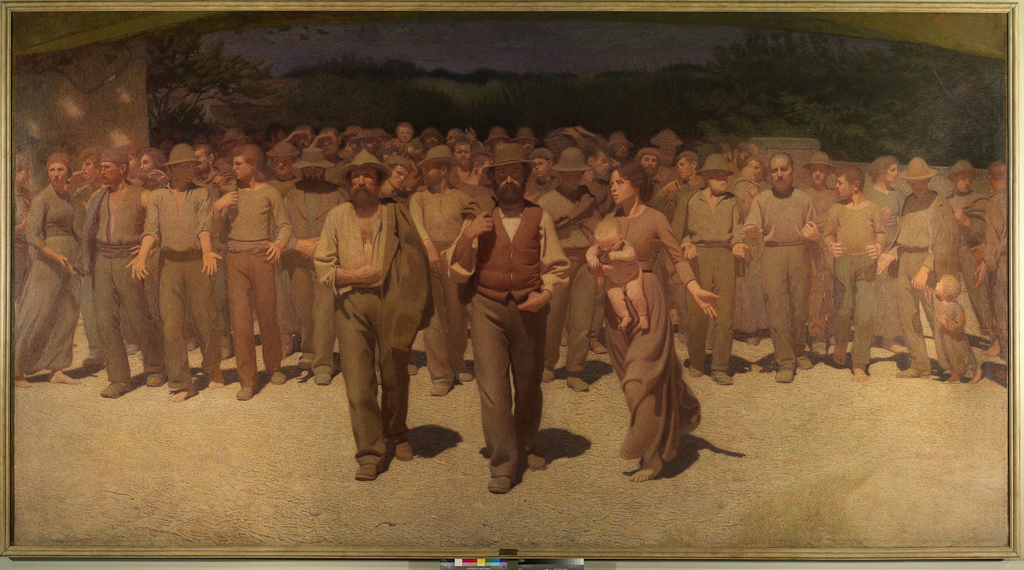
I saw The Fourth Estate by Giuseppe Pellizza da Volpedo at the Royal Academy in
1980. This was shortly before I went to art school. It was exhibited in ‘Postimpressionism : cross currents in European painting’. It is a painting that has stayed with me all these years.
When I began This Charter’d City I was intent on painting at least one figure who would look straight at the viewer. Eventually, I made sure three of the four central figures did this. I used the trick of having them stare straight ahead. The human brain does the rest by converting the flat image into a 3D one, which is why, no matter where viewers stand, these figures directly engage them. And I learned this from The Fourth Estate where the central figure does exactly this.
An exhibition

Photograph of the London Biennale, courtesy of Liz Isles and the Gagliardi Gallery
In June 2023, This Charter’d City was selected for the London Biennale where it was awarded an ICAC Art Critics prize
The picture represents the summation of a decade’s work developing figurative paintings that I hope convey a sense of urban modernity.
I’ve tried to capture the essence of the city. One that has been historically driven
by the human desire for wealth and power. A city that attracts people from the
four corners of the earth, searching for refuge and the chance to make a new life.
A city that constantly spreads itself outwards and upwards.
So, this is modern London, the charter’d city of my birth.